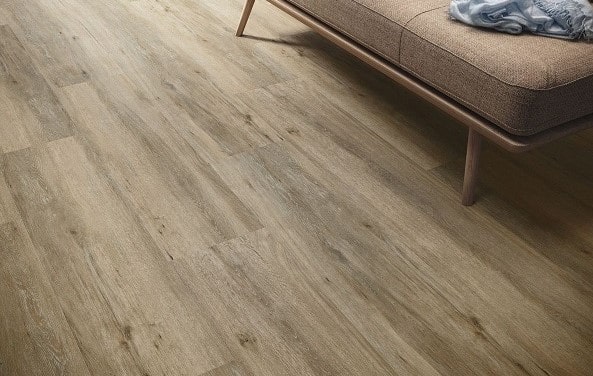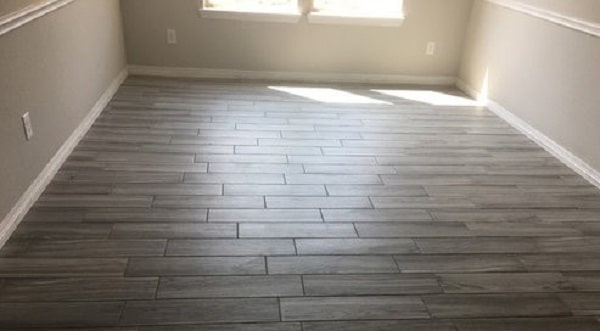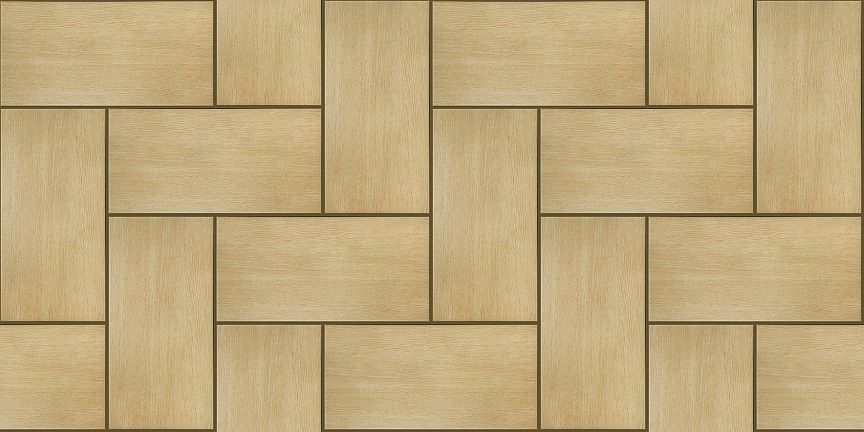by Liz Gonzales
One way to add the luxurious hardwood look to your home is to consider using porcelain wood tile flooring. Not only is this product full of benefits but it also provides beauty to the rooms. Keeping in mind that the product you select guarantees to impact everything in your property is key. So, before you decide if this is fit for your household or business needs, looking at the pros and cons closely is in order. Read on and determine it is worth investing in or not.
Contents

Porcelain wood tile is a popular flooring option for homeowners that want the natural warmth and beauty of wood, but with fewer of the disadvantages that come with natural materials. Wood flooring can be damaged by moisture, including condensation from hot or cold beverages; it also shrinks and expands in different weather conditions; pets may scratch it; and it can be expensive and difficult to replace. Porcelain wood tile is a visually stunning, easy-to-clean substitute that offers many of the same benefits as traditional hardwood flooring.
Porcelain wood tile floors are now easier than ever to install with new installation materials such as thin set mortar, which provides a strong bond that doesn't require the use of nails, screws or glue. In addition to being easy to install, porcelain wood tile is easy to maintain and resists staining from spilled liquids and dirt tracked in from outside.
The natural beauty of wood comes from the grain pattern visible in the tile's surface. Porcelain woods come in a variety of different colors, including matte finishes and stained finishes with a 3D effect. The individual tiles can be set next to each other with a small gap between them for a more authentic texture, or they can be installed so tightly that no gaps are visible at all. This option is particularly popular with homeowners who have young children or pets because it eliminates tripping hazards. Additionally, these tiles are even more resistant to staining than traditional wood floors, making them popular in rooms like kitchens and mudrooms.
Porcelain tiles come in several standard sizes including 12-inchx12-inch; 6-inchx36-inch; 24-inchx24-inch; 18-inchx18-inch; and the unique 10" x 33" or 22 1/2" x 11 3/4" planks. They're typically sold in boxes of twelve each, with the price varying based on type, size, manufacturer and quantity. Installing these tiles is a time consuming process that requires skilled labor so it's usually cost effective to have your contractor purchase materials for you rather than buying them yourself.

The number of households that have wood tiles is regularly growing today. Of course, its related benefits are tremendously helpful for homeowners. Thus, the is always an unbeatable flooring option.
Like other flooring materials in the market, the cost of porcelain tile varies. This includes the amounts needed to buy, install, and maintain in comparison to other materials. Considering the impacts, it has on the home's value, it's clear that the usage of these tiles is truly beneficial. Generally, this product is by far less expensive for every square foot. So, it is a budget-friendly way of making your surfaces. Ensure you get a professional to tackle the installation. That means the price should be factored in the overall budget.
The time porcelain material got introduced into this sector there were limited style options. However, lately, the tile has different design options all thanks to technology. This flooring material imitates the look of hand-made oak, highly finished mahogany or the type you desire to have in your house. Be sure of an unlimited wood-like porcelain tile range.
The manufacturer applies a high-grade inkjet tech. This prints that wood-like look onto the tile's surface giving incredible practicality on looks and texture. As a man-made product, these tiles are available in a range of finishes, colors, and textures. Choosing from the wide-ranging selection makes it easy to identify the tile created for elevating your room's style.
Cleaning any type of wood flooring needs special products and techniques. Generally, take caution to avoid wetting the floor too much or even to use harsh cleansers. Following the recommendations will make cleaning porcelain quite easy. Just sweep or vacuum as required without the fears of having warping or bubbly floors due to exposure to water. Avoid using harsh cleaning products, either acidic or scratchy, as this causes damage over time. If a thorough clean is needed, just a mop and soapy water are enough. The fact that it is so easy to clean makes it both a pet and an allergy-friendly choice as well.
Traditional hardwoods are particularly prone to both scratch and water damages. Porcelain tile is known to be strong enough and worth installing in heavy traffic areas at home. The front doors to the kitchen and bathrooms, however, will not show signs of scratches or wear due to foot traffic.
The material not only withstands the everyday wear and tear from the family, but it also extremely resists water without swelling or warping even with exposure to high moisture content. This flooring can remain in any home for many decades when you are carefully handling it. Considering periodic polishing or refinishing is essential to keep its original shape. So, take proper steps to maximize its lifespan.
The fact is that most homes have both pets and kids. This makes you often concerned about spills, odors, accidents, and even scratches. But because tiled floors are very durable, it is a perfect fit to be used in homes having children and pets.

Every home rarely finds an ideal flooring material type. As it turns out with the other floors, porcelain wood tiles have downsides too. So before investing in this be aware of things like:
Even though listed among the durable floors, porcelain tiles are prone to scratches and damages over time. Dropping something even from some feet directly above this floor can cause breakage. Further to that finding, an accurate material match needed for repairs after some years is nearly difficult. Why? The styles are currently changing with technology advancements.
Unlike hardwood flooring, a scratched porcelain floor cannot be polished or be refinished to obtain the new look. Failure to get a matching piece will mean you uninstall everything or opt for a miss-match. That is unpleasing to the eye and is easily noticed by guests.
Porcelain tiles always need grout to stay in the original place. With frequent use of the floors, the part collects dirt and starts looking grimy. As a result, a thorough cleaning is necessary to restore the floors looks. Sometimes the material does not look decent enough. This will translate into an expensive rip out and refinishing or replacing it. And to redo some surfaces like in the kitchen may call for a lot of money.
Porcelain tile is a hard flooring surface and tends to be cold to touch under the feet. The material is thus not often comfortable especially if you spend long hours walking across or even standing on it. Even more, the other concern is how it echoes noises greatly, unlike hardwoods.
This is a disadvantage during the cold seasons especially to family members allergic to cold. Yes, you know how bad the feet feel while in the kitchen. The pets as well become fatigued due to constantly stepping on the floor.
Installing porcelain tiles is quite challenging. The products come as long and thin planks like the natural hardwood boards. For you to get the maximum benefits from the tiles, an expert is highly recommended for the installation job. Of course, cutting the tiles down to the desired size is an art.
The process is also time-consuming and particularly when multiple rooms are to be floored. Many preparations will be needed so turns out to be expensive. Leave the work to a pro or rather if you are experienced enough to handle it then follow the instructions from the manufacturer keenly.
Equally, if there is a need to change the flooring in the future, then consider professional removal. It is obvious if you do not involve an expert in the process you may end up investing in new materials adds to labor costs.

Porcelain tiles come in rough or hand-scraped appearances. The types of finishes make the floor not slippery while walking on. But the flooring can become slick when wet either during cleaning or due to spills. Children and pets can slip on such surfaces and encounter bad accidents. Due to temperature and humidity changes, the tiles can crack which is another threat that causes falls.
Porcelain wood floors are often used in kitchens, mudrooms and bathrooms because they resist water damage. They can be installed over any type of subfloor including concrete, plywood or even existing hardwood floors. Flooring manufacturers may recommend that you install a moisture barrier like plastic sheeting or a vapor retarder to prevent water damage.
Porcelain wood flooring is durable and attractive, but it's not always the right choice for your home. It can be difficult to cut, scratch or dent. Porcelain wood floors are also more slippery than traditional hardwood floors when wet. Homeowners with young children should avoid installing porcelain wood flooring in their homes because these floors are too easy to slip on while wet. This is especially important if there are small children who may play near the entrance of the house where spills of all kinds are likely to occur. If you're worried about slips and falls, consider using low-gloss ceramic tile instead of high-gloss porcelain wood flooring. Ceramic tile is available in many trendy colors and patterns that look like porcelain wood flooring, but without the same risk of slips.
Porcelain wood floors are remarkably durable because they're made with ceramic, not real hardwood. They have a high polish that makes them resistant to scratches and stains while still being very lightweight. This type of wood flooring is easy to install and it can be used anywhere inside your home including bathrooms, mudrooms or kitchens where there may be spills from food or water. Porcelain wood flooring comes in different widths so you should have no problem finding one that perfectly matches your space's dimensions. Installation is easy because the boards come pre-assembled so all you have to do is lay them in place. Some porcelain wood tiles even come with a built-in underlayment that eliminates the need for polyurethane padding underneath the boards.
The most important part in properly caring for porcelain tiles is proper preparation. A surface must be free of any dirt, oil or other contaminants before the sealer is applied to ensure that it will bond correctly to the tile and form a protective film that can be easily maintained by mopping with hot water. After mopping, be sure to allow the floor to dry thoroughly and check for any areas that may need additional treatment.
If the tiles are not glazed or sealed before installation, they can be mopped with an approved sealer as soon as they have been installed. This is usually done after grouting to avoid getting sealer on the grouting material.
To prevent staining, it is important that the surface be free of any water-soluble deposits or stains before applying a sealant. If present, these should be removed by gentle scrubbing with an acidic cleaner followed up with mopping to remove excess residue and allow to dry thoroughly.
Mop the floor to remove any excess dirt, sand or other abrasives that may have become loose during installation. Rinse off the mop with clean water and wipe dry. This will prevent any dirt or abrasives from scratching the surface when applying a sealer.
In some circumstances, it might be necessary to sand the tiles before sealing in order to fill in any small scratches on the tile's surface made during installation or caused by moving furniture across them. If this is required, use a fine-grit sandpaper (220 grit) and go over the entire floor lightly to ensure smoothness of application. Wipe clean with a cloth dampened with mineral spirits. Allow to dry completely before proceeding with sealing.
Always follow the manufacturer's instructions for any sealers you choose to use. It is usually best to apply more than one coat, allowing sufficient time between applications for it to dry completely before applying another. The surface should be kept free of dirt and other contaminants during the drying period as this will interfere with bonding.
For a no-wax or low-wax sealer, allow 24 hours between each coat and be sure not to apply it on wet tile as this may cause streaking.
Before mopping with hot water, test a hidden area first to make sure that the tiles do not have a sheen that could easily be removed by rubbing a damp cloth over it. If they do, a new coat of sealer should be applied.
Mop the floor with clean water before applying any solution to avoid leaving excess dirt or other contaminants on the surface that could affect bonding. For especially stubborn stains, art cleaners can be used after mopping with hot water; however, make sure they are approved for use on tile floors and properly rinse off all remaining residue before sealing.
To mix your own cleaner, dissolve two tablespoons of white distilled vinegar in one quart of hot water along with 15 drops (or more depending on desired strength) of an essential oil such as lavender to act as an antibacterial agent to prevent mold formation. Apply this over the entire floor using a spray bottle, allowing it to sit for about five minutes before mopping. Be sure to allow the floor to dry completely before sealing.
If the surface is dull after the final coat of sealer has dried, buffing with steel wool (grade 0000) will help restore its luster. However, be careful not to scratch it when cleaning or mopping. You can also clean it with a solution of equal parts rubbing alcohol and water using a white cotton cloth.
It is important to reseal porcelain wood tile every 6 to 12 months, depending on the amount of foot traffic in the area, in order to maintain the floor's water resistance.
If your porcelain wood tile floor has scratches or small holes, fill them in with a matching colored grout before resealing the surface. The sealer will prevent the color from fading and flaking off as well as give you a longer-lasting and more polished finish.
Porcelain wood tiles currently are a superior choice for many homeowners. Of course, appreciating this old-style elegance means more flexibility and durability. If you want to install this product, however, it is vital to weigh its pros and cons. Generally, when selecting this either for residential or commercial use check the material used for designing. Its many benefits make it clear why this flooring option is so popular now.
 |
 |
 |
 |

About Liz Gonzales
Liz lives in a suburb in New York city.
Both of her parents are the art professors at Sate University of New York.
As such, Liz grew up with all kinds of art objects, portraits, and books laying around the home.
Liz met up with Linea through another friend in some kind of online art forum. There great minds sparkled to take their passions onto the next level @ linea.io.
 |
 |
 |
 |
You can Get FREE Gifts. Furthermore, Free Items here. Disable Ad Blocker to receive them all.
Once done, hit anything below
 |
 |
 |
 |